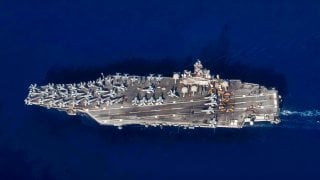'Drone' Aircraft Carriers: Coming Soon to the U.S. Navy
General Atomics has introduced the Gambit 5, a new drone specifically designed for aircraft carrier operations. Part of the Gambit family, which includes drones tailored for various missions like air combat and stealth reconnaissance, the Gambit 5 features reinforced landing gear and a tail hook for catapult launches and arrested landings.
Summary and Key Points: General Atomics has introduced the Gambit 5, a new drone specifically designed for aircraft carrier operations. Part of the Gambit family, which includes drones tailored for various missions like air combat and stealth reconnaissance, the Gambit 5 features reinforced landing gear and a tail hook for catapult launches and arrested landings.
-Built to endure the extreme conditions of carrier takeoffs and landings, it is likely powered by a jet turbofan engine, enabling faster speeds essential for carrier-based operations.
-This development aligns with growing interest in carrier-capable drones, particularly as nations like China advance similar technologies.
Gambit 5: The New Drone Set to Revolutionize Aircraft Carrier Operations
General Atomics has revealed a new drone designed to operate from aircraft carriers.
With China very likely developing an aircraft carrier for drones, unmanned aerial systems are becoming increasingly relevant in naval operations.
Gambit 5
General Atomics announced the Gambit 5 unmanned aerial system that can operate from carriers.
Part of the Gambit drone family, the new unmanned aerial system shares a core chassis with four other drones. The Gambit 1 is an intelligence, surveillance, and reconnaissance design; the Gambit 2 is an air-to-air combat design; the Gambit 3 is an air target design; and the Gambit 4 is a stealth reconnaissance design.
“There’s a lot that has to go into making the Gambit 5 carrier-capable [in terms of] the catapult launch and arrested landing. How do you reinforce the landing gear? How do you add the tail hook? How do you ‘marinize’ the airframe? All those considerations come into play,” C. Mark Brinkley, GA-ASI’s senior director for strategic communications and marketing, said during an aerospace event earlier this year.
“We’ve been reinforcing aircraft to take off and land on aircraft carrier for a very long time. There’s no specifically new science to that,” Brinkley added.
Aircraft that operate from carriers require a stronger airframe that can withstand the immense pressures of landing and take-off from a carrier. For example, an F-16 fighter jet requires between 3,000 and 3,500 feet of runway to take off. In comparison, fighter jets operating from aircraft carriers take off from a runway around 300 feet long.
Moreover, aircraft operating from U.S. carriers use steam catapults – or electromagnetic catapults in the case of the new USS Gerald R. Ford – that propel an aircraft to 200 miles per hour in just a few seconds. Manned and unmanned aircraft designed for carrier operations are therefore built differently.
General Atomics has substantive experience with drones. It designed and produced the very successful MQ-1 Predator and MQ-9 Reaper and has been developing the MQ-20 Avenger – a drone with stealth characteristics that is similar to the MQ-9 – for almost two decades now.
The Gambit 5 is likely to use a jet turbofan engine instead of a turboprop like the MQ-1 or MQ-9. A jet turbofan engine produces more thrust, and the aircraft is able to fly at faster speeds.
That capability makes sense – carrier air operations depend on the speed and condition of the ship. A slower manned or unmanned aircraft will always land back on its ground base, but when approaching a carrier, an aircraft will need to be faster to match the speed of a moving ship.
About the Author
Stavros Atlamazoglou is a seasoned defense journalist specializing in special operations and a Hellenic Army veteran (national service with the 575th Marine Battalion and Army HQ). He holds a BA from the Johns Hopkins University and an MA from the Johns Hopkins’ School of Advanced International Studies (SAIS). His work has been featured in Business Insider, Sandboxx, and SOFREP.
Image Credit: Creative Commons.


